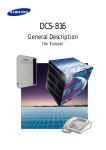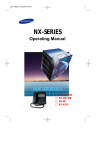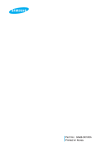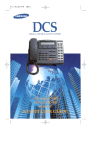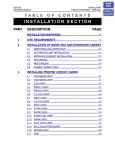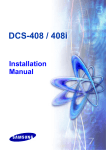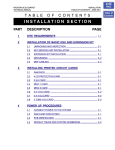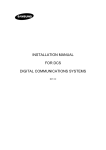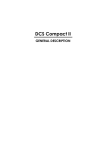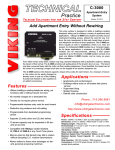Download DCS 7B Installation manual
Transcript
SAMSUNG DCS-816 INSTALLATION MANUAL Technical Manuals Online! - http://www.tech-man.com SAMSUNG ELECTRONICS CO. LTD. Publication Information Samsung Electronics reserves the right without prior notice to revise information in this publication for any reason. Samsung Electronics also reserves the right without prior notice to make changes in design or components of equipment as engineering and manufacturing may warrant. Copyright 1999 Samsung Electronics Co. Ltd All rights reserved. No part of this manual may be reproduced in any form or by any means - graphic, electronic or mechanical, including recording, taping, photocopying or information retrieval systems without express written permission of the publisher of this material. March/99 Technical Manuals Online! - http://www.tech-man.com SAMSUNG DCS-816 Installation March 1999 Table of Contents PART 1. SITE REQUIREMENTS..................................................................................... 1-1 PART 2. INSTALLING THE BASIC KSU … … … … … … … … … … … … … … … … … … … …2-1 2.1 2.2 2.3 2.4 2.5 2.6 2.7 System Configuration and Capacity ..................................................................................................... 2-1 Unpacking and Inspection .................................................................................................................... 2-2 Mounting the KSU (Figure 2-1) ............................................................................................................ 2-2 Grounding the KSU (Figure 2-2) .......................................................................................................... 2-3 MDF Cabling (Figure 2-3)..................................................................................................................... 2-3 External Battery Connection (Figure 2-4)............................................................................................. 2-6 Selecting Options on the Basic KSU (Figure 2-5) ................................................................................ 2-7 PART 3. INSTALLING OPTION CARDS AND TRUNK CARDS (FIGURE 3-1) .............. 3-1 3.1 3.2 3.3 3.4 3.5 SIO1 Option Card (Figure 3-2) ............................................................................................................. 3-2 AA Option Card (Figure 3-2) ................................................................................................................ 3-2 8TRK Card (Figure 3-3)........................................................................................................................ 3-3 2/4BRI Card (Figure 3-3)...................................................................................................................... 3-3 4TRK Card (Figure 3-4)........................................................................................................................ 3-4 PART 4. POWER-UP PROCEDURE … … … … … … … … … … … … … … … … … … … … … ..4-1 4.1 4.2 4.3 4.4 Connect Power to the System (Figure 4-1, 4-2)................................................................................... 4-1 Monitor LED Indication and Memory Backup Selection ....................................................................... 4-3 PCB Verification ................................................................................................................................... 4-3 Default Trunk and Station Numbering.................................................................................................. 4-3 PART 5. CONNECTING PSTN CIRCUITS .… … … … … … … … … … … … … … … … … … … .5-1 5.1 5.2 5.3 5.4 Safety Precautions ............................................................................................................................... 5-1 Loop-Start Lines (Figure 5-1) ............................................................................................................... 5-2 Off Premise Extension (OPX) (Figure 5-2) .......................................................................................... 5-3 ISDN BRI Lines (Figure 5-3) ................................................................................................................ 5-4 PART 6. CONNECTING STATION EQUIPMENT 6.1 6.2 6.3 6.4 6.5 6.6 … … … … … … … … … … … … … … … ...6-1 Safety Precautions ............................................................................................................................... 6-1 Digital Keysets (Figure 6-1) .................................................................................................................. 6-2 Single Line Telephones (Figure 6-2) .................................................................................................... 6-3 Door Phone and Door Lock Release (Figure 6-3)................................................................................ 6-4 CTM - CTI Module (TAPI) (Figure 6-4) ................................................................................................ 6-5 ISDN TE (ISDN Phone, G4 FAX, etc) (Figure 6-5) .............................................................................. 6-6 PART 7. CONNECTING OPTIONAL EQUIPMENT … … … … … … … … … … … … … … … .7-1 7.1 Music-on-Hold/ Background Music (Figure 7-1)................................................................................... 7-1 7.2 External Paging (Figure 7-2) ................................................................................................................ 7-2 7.3 Common Bell (Figure 7-3).................................................................................................................... 7-3 7.4 Ring Over Page.................................................................................................................................... 7-4 7.5 Station Message Detail Recording (SMDR) (Figure 7-4) ..................................................................... 7-4 7.6 PC Programming (Figure 7-5).............................................................................................................. 7-5 7.7 Remote Programming (Figure 7-6) ...................................................................................................... 7-6 7.8 Power Failure Transfer......................................................................................................................... 7-6 7.9 Voice Mail/ Auto Attendant (Figure 7-7) ............................................................................................... 7-7 7.10 Information on DCS-816 Serial Interface (Figure 7-8) ....................................................................... 7-8 i Technical Manuals Online! - http://www.tech-man.com SAMSUNG DCS-816 Installation March 1999 PART 8. CHANGING SOFTWARE (FIGURE 8-1)… … … … … … … … … … … … … … … … 8-1 FIGURES FIGURE 2-1 FIGURE 2-2 FIGURE 2-3 FIGURE 2-4 FIGURE 2-5 ATTACHING MOUNTING BRACKET TO BACKBOARD GROUNDING THE KSU MDF CABLING CONNECTING A SYSTEM BACKUP BATTERY SELECTING OPTIONS ON THE BASIC KSU FIGURE 3-1 FIGURE 3-2 FIGURE 3-3 FIGURE 3-4 INSTALLING OPTION CARDS AND A TRUNK CARD SIO OPTION CARD AND AA OPTION CARD 8TRK CARD AND 2/4BRI CARD 4TRK CARD FIGURE 4-1 FIGURE 4-2 CONNECTING POWER TO THE SYSTEM REPLACING FUSES (POWER SUPPLY UNIT) FIGURE 5-1 FIGURE 5-2 FIGURE 5-3 CONNECTING LOOP-START LINES CONNECTING OPX LINES CONNECTING BRI LINES FIGURE 6-1 FIGURE 6-2 FIGURE 6-3 FIGURE 6-4 FIGURE 6-5 CONNECTING DIGITAL KEYSETS CONNECTING SINGLE LINE TELEPHONES CONNECTING A DOOR PHONE AND LOCK RELEASE CONNECTING A CTM (TAPI) CONNECTING ISDN TE FIGURE 7-1 FIGURE 7-2 FIGURE 7-3 FIGURE 7-4 FIGURE 7-5 FIGURE 7-6 FIGURE 7-7 FIGURE 7-8 CONNECTING EXTERNAL MUSIC CONNECTING EXTERNAL PAGING EQUIPMENT CONNECTING AN EXTERNAL LOUD BELL PIN CONNECTIONS TO PRINTER PIN CONNECTIONS TO PC PIN CONNECTIONS TO MODEM CONNECTING VM/AA INFORMATION ON SERIAL INTERFACE FIGURE 8-1 CHANGING SOFTWARE ii Technical Manuals Online! - http://www.tech-man.com SAMSUNG DCS-816 Installation March 1999 PART 1. SITE REQUIREMENTS To install the DCS-816 system, choose a site that meets the following requirements. ü Select a location for the Key Service Unit (KSU) that has enough space for easy installation and adequate lighting. (KSU dimensions [mm]: 465 (H) x 315 (W) x 120 (D)) ü Select a location that minimises cable lengths. See the Cable Requirements table below. ü The equipment should not be exposed to direct sunlight, corrosive fumes, dust, constant vibration or strong magnetic fields such as those generated by motors and copy machines. ü A direct commercial AC power outlet is required. Do not use extension cords. Preferably, a dedicated circuit should be used to minimise the risk of other electrical equipment being connected that could adversely affect system operation. ü Ensure that all wires and cables going to and coming from the KSU are properly routed. Do not cross fluorescent lights or run parallel with AC wires. ü The equipment must be located in an environment that will maintain a temperature range of 32°F ~ 104°F (0°C ~ 40°C) and a humidity range of 10% ~ 90% non-condensing. ü Allow at least 150 mm clearance on both sides and 150 mm clearance on top of the KSU to ensure proper ventilation. ü Do not install within a 2-mile radius of broadcasting antenna or in close proximity to a fire sprinkler head or other sources of water. Meeting these requirements will help to ensure proper performance and greater life expectancy of the system. CABLE REQUIREMENTS EQUIPMENT DIGITAL KEYSETS SINGLE-LINE STATION DOOR PHONE CTI INTERFACE MODULE CABLE 1 PR. TWISTED 1 PR. TWISTED 2 PR. TWISTED 1 PR. TWISTED Gauge 0.5mm 0.5mm 0.5mm 0.5mm MAX FEET 1300 3000 330* 1300 * This is the maximum distance a door phone can be from the DPIM. maximum of 250 cable metres from the KSU 1-1 Technical Manuals Online! - http://www.tech-man.com MAX METRES 400 1 KM 100 400 The DPIM can be a SAMSUNG DCS-816 Installation March 1999 NOTICE Only qualified engineers or technicians can have access to the inside of the system. In most countries, it is prohibited by law that non-qualified people install or maintain systems. 1-2 Technical Manuals Online! - http://www.tech-man.com SAMSUNG DCS-816 Installation March 1999 PART 2. INSTALLING THE BASIC KSU 2.1 SYSTEM CONFIGURATION AND CAPACITY The DCS-816 system consists of the Basic Key Service Unit (KSU), option cards, trunk interface cards, interface modules and digital keysets. The KSU is a single metal cabinet, and in its basic form has 16 station ports: twelve (12) keyset ports and four (4) SLT (single line telephone) ports. Additionally, the KSU contains one (1) trunk expansion slot, two (2) option connectors and miscellaneous circuits: one (1) external page interface, one (1) general-purpose dry contact and one (1) music interface selectable to internal built-in music (a melody chip) or external music. Two types of telephones can be connected to the system: proprietary digital stations called "keysets" that connect to Digital Line Interface (DLI) ports and standard telephone sets, generally called "single line telephones", that connect to Single Line Interface (SLI) ports. The Trunk Expansion slot provides an option to select an analogue trunk card or a basic rate interface (BRI) card. The DCS-816 system also has some option cards to provide serial I/O ports or AA facilities. The KSU starts with two (2) analogue trunk ports and 16 stations, and the trunk expansion slot provides a maximum capacity of 10 trunk ports (analogue or digital) and 16 stations. The system maximum capacity is as follows: Stations ISDN channels Analogue C.O. lines 16 (12 keysets, 4 SLTs) 8 (4 BRI ports) 10 Music channel External page General-purpose Dry Contact 1 (Internal or External) 1 1 Serial I/O ports Auto Attendant channels 2 (DB9 connectors) 4 CONFIGURATION NOTES 1. 2. 3. 4. No KDbs (keyset daughter-boards for additional DLI or SLI expansion) can be installed. Only one (1) trunk expansion card can be installed. Only one SIO option card and one AA option card can be installed. The system cannot accommodate any cards from other Samsung Digital Systems except for DCS Compact BRI cards. 5. Every analogue trunk interface contains an interface for MPD or PRS which is optional. The MPD or PRS hybrid chips of the DCS system can be used. 2-1 Technical Manuals Online! - http://www.tech-man.com SAMSUNG DCS-816 Installation March 1999 2.2 UNPACKING AND INSPECTION After unpacking the KSU, inspect for any signs of physical damage. If any damage is detected, do not attempt to install. Contact the local distributor for advice. Check to see that the Basic KSU carton includes the following items. ü Basic Key Service Unit (KSU) ü AC Power Cord ü Wall-mount bracket ü Spare fuses ü Cable ties and screws ü Battery connection cable ü SLT User’s Guide (Standard telephone) 2.3 MOUNTING THE KSU (Figure 2-1) DCS-816 can be wall-mounted. The KSU should be mounted on a plywood backboard at least 15 mm thick. Attach the wall-mount bracket to the backboard with the screws supplied and hang the KSU on the bracket. ATTACHING MOUNTING BRACKET TO BACKBOARD 2-2 Technical Manuals Online! - http://www.tech-man.com FIGURE 2-1 SAMSUNG DCS-816 Installation March 1999 2.4 GROUNDING THE KSU (Figure 2-2) DCS-816 comes equipped ready to use with the third wire AC ground provided through the power cord. This ground will be adequate for most applications. However, if it is suspected that there is a problem with the ground provided at the AC outlet, or local codes require a solid earth ground to be connected to the KSU, the existing third wire ground must be disconnected before power is applied. The grounding lug on the KSU must be connected to a ground rod or metal cold water pipe using #10 AWG (approximately 2.6 mm in diameter) solid copper wire. (See Figure 2-2.) Failure to provide an adequate ground may cause unpredictable operation or even circuit failure. Warning Unplug the power cord from the AC outlet before attempting to connect the ground. Hazardous voltage may cause death or injury. Observe extreme caution when working with AC power. GROUNDING THE KSU FIGURE 2-2 2.5 MDF CABLING (Figure 2-3) All connections to the DCS-816 system are made via a customer–provided main distribution frame (MDF) and the cables can be routed into the KSU cabinet from below. A 25-pair male champ connector and a 4-pair modular jack (RJ-45) on the base board are prepared for external connections. The connections for SLTs are made through the RJ-45 modular jack and other connections are made through the champ connector. The detailed pin assignments are as follows. (Note that the colour of wires may be differently specified in some countries.) 2-3 Technical Manuals Online! - http://www.tech-man.com SAMSUNG DCS-816 Installation March 1999 Details of Champ Connections The first 20 pins are assigned to connections for trunk interfaces on a trunk interface card as well as on the base board. The next 6 pins are for connection of miscellaneous circuits and the last 24 pins are assigned to connections for 12 DLI ports on the base board. Pin 26 1 27 2 28 3 29 4 30 5 31 6 32 7 33 8 34 9 35 10 36 11 37 12 38 13 39 14 40 15 41 16 42 17 43 18 44 19 45 20 46 21 47 22 48 23 49 24 50 25 Colour W-BL BL-W W-O O-W W-GR GR-W W-BR BR-W W-S S-W R-BL BL-R R-O O-R R-GR GR-R R-BR BR-R R-S S-R BK-BL BL-BK BK-O O-BK BK-GR GR-BK BK-BR BR-BK BK-S S-BK Y-BL BL-Y Y-O O-Y Y-GR GR-Y Y-BR BR-Y Y-S S-Y VL-BL BL-VL VL-O O-VL VL-GR GR-VL VL-BR BR-VL VL-S S-VL Circuits/ Functions st Tip, 1 Loop-start Trunk Interface on the base board st Ring, 1 Loop-start Trunk Interface on the base board nd Tip, 2 Loop-start Trunk Interface on the base board nd Ring, 2 Loop-start Trunk Interface on the base board rd st Tip of 3 Analogue Trunk or Tip of 1 BRI TX rd st Ring of 3 Analogue Trunk or Ring of 1 BRI TX th st Tip of 4 Analogue Trunk or Tip of 1 BRI RX th st Ring of 4 Analogue Trunk or Ring of 1 BRI RX th nd Tip of 5 Analogue Trunk or Tip of 2 BRI TX th nd Ring of 5 Analogue Trunk or Ring of 2 BRI TX th nd Tip of 6 Analogue Trunk or Tip of 2 BRI RX th nd Ring of 6 Analogue Trunk or Ring of 2 BRI RX th rd Tip of 7 Analogue Trunk or Tip of 3 BRI TX th rd Ring of 7 Analogue Trunk or Ring of 3 BRI TX th rd Tip of 8 Analogue Trunk or Tip of 3 BRI RX th rd Ring of 8 Analogue Trunk or Ring of 3 BRI RX th th Tip of 9 Analogue Trunk or Tip of 4 BRI TX th th Ring of 9 Analogue Trunk or Ring of 4 BRI TX th th Tip of 10 Analogue Trunk or Tip of 4 BRI RX th th Ring of 10 Analogue Trunk or Ring of 4 BRI RX Tip, General-purpose Dry Contact on the base board Ring, General-purpose Dry Contact on the base board Tip, External Page Interface on the base board Ring, External Page Interface on the base board Tip, External Music Interface on the base board Ring, External Music Interface on the base board st Tip, 1 DLI port on the base board st Ring, 1 DLI port on the base board nd Tip, 2 DLI port on the base board nd Ring, 2 DLI port on the base board rd Tip, 3 DLI port on the base board rd Ring, 3 DLI port on the base board th Tip, 4 DLI port on the base board th Ring, 4 DLI port on the base board th Tip, 5 DLI port on the base board th Ring, 5 DLI port on the base board th Tip, 6 DLI port on the base board th Ring, 6 DLI port on the base board th Tip, 7 DLI port on the base board th Ring, 7 DLI port on the base board th Tip, 8 DLI port on the base board th Ring, 8 DLI port on the base board th Tip, 9 DLI port on the base board th Ring, 9 DLI port on the base board th Tip, 10 DLI port on the base board th Ring, 10 DLI port on the base board th Tip, 11 DLI port on the base board th Ring, 11 DLI port on the base board th Tip, 12 DLI port on the base board th Ring, 12 DLI port on the base board 2-4 Technical Manuals Online! - http://www.tech-man.com Remark No polarity No polarity Expansion card No polarity Expansion card No polarity Expansion card No polarity Expansion card No polarity Expansion card No polarity Expansion card No polarity Expansion card No polarity Expansion card No polarity No polarity No polarity No polarity No polarity No polarity No polarity No polarity No polarity No polarity No polarity No polarity No polarity No polarity No polarity No polarity SAMSUNG DCS-816 Installation March 1999 Details of RJ-45 Connections Eight pins of the RJ-45 connector are assigned to connections of SLT interface ports on the base board. Pin No. 1 8 2 7 3 6 4 5 Circuits/ Functions st Tip, 1 SLT port (STN 13) on the base board Ring, 1st SLT port (STN 13) on the base board Tip, 2nd SLT port (STN 14) on the base board Ring, 2nd SLT port (STN 14) on the base board Tip, 3rd SLT port (STN 15) on the base board Ring, 3rd SLT port (STN 15) on the base board Tip, 4th SLT port (STN 16) on the base board Ring, 4th SLT port (STN 16) on the base board Remarks OPX Circuit No polarity OPX Circuit No polarity No polarity No polarity BOTTOM VIEW FRONT VIEW AFTER REMOVING THE FRONT COVER FROM 50-PIN CHAMP CONNECTOR FROM 8-PIN RJ-45 MDF CABLING FIGURE 2-3 2-5 Technical Manuals Online! - http://www.tech-man.com SAMSUNG DCS-816 Installation March 1999 2.6 External Battery Connection (Figure 2-4) It is recommended that an external battery should be installed to backup the system in case of AC power failure. The DCS-816 system is equipped with battery charging and discharging circuits to interface with an external battery. To decide the capacity of the battery, keep in mind that it may damage the system if too large while it cannot backup the system long enough if too small. The capacity should be not less than 6AH nor more than 26AH. The battery voltage should be 48 volts. To connect an external battery, first pick out the battery connection cable through the MDF cable path. Connect the RED lead of the cable to the positive (+) terminal of the battery and the BLACK lead to the negative (-) terminal. Then insert the housing connector into the header in the power supply. NOTE: The actual connection should be done as the final step in the installation of the KSU. ü CONNECTING A SYSTEM BACKUP BATTERY 2-6 Technical Manuals Online! - http://www.tech-man.com USE EXTREME CAUTION ON THE POLARITY AND THE INRUSH CURRENT AT THE POINT OF CONNECTION FIGURE 2-4 SAMSUNG DCS-816 Installation March 1999 2.7 Selecting Options on the Basic KSU (Figure 2-5) There are some hardware options to select in the Basic KSU: Memory Backup Selection, Music Source Selection and MPD/PRS selection for the two (2) analogue trunk lines on the base board. 2.7.1 Memory Backup Selection The system is equipped with 256Kbyte of data memory and memory backup circuitry (a super capacitor) to protect the data in case of any power failure. The memory backup circuitry has a shunt-pin switch to enable backup. Before shipment, the switch is set OFF to prevent the super capacitor from discharging during shipment and storage, and it should be switched ON after installing and programming the system. Otherwise, the customer data and the programmed data will be lost in the event of a power failure. (See Figure 2-5.) 2.7.2 Music Source Selection The Basic KSU is equipped with a melody chip to provide music to stations and trunk lines as Music-on-Hold or Background Music. In addition, it has an interface for an external music source, (CD player, radio etc). As the system provides only a single music channel for Music-on-Hold or Background Music, refer to Figure 2-5 to select the music source at the end of installation. A shunt-pin switch selects the music source: the internal melody chip or an external music source. How to connect the external music source is explained in Part 7. 2.7.3 MPD/ PRS Selection and Installation The Basic KSU has two (2) analogue trunk interfaces and each trunk interface is equipped with a socket to install an option chip for Metering Pulse Detection (MPD) or Polarity Reverse Signal (PRS) detection. (See Figure 2-5 for position of option chip sockets and ensure that the chips are firmly inserted into the sockets.) One chip per line. DCS option chips for MPD or PRS can be installed. Contact your dealer for details. 2-7 Technical Manuals Online! - http://www.tech-man.com SAMSUNG DCS-816 Installation March 1999 MPD/PRS SOCKET FOR TRK1 MPD/PRS SOCKET FOR TRK2 MUSIC SOURCE EXT INT MEMORY BACKUP ON OFF SELECTING OPTIONS ON THE BASIC KSU 2-8 Technical Manuals Online! - http://www.tech-man.com FIGURE 2-5 SAMSUNG DCS-816 Installation March 1999 PART 3. INSTALLING OPTION CARDS AND TRUNK CARDS (Figure 3-1) Unpack and inspect each card before installing. Check for signs of physical damage. If any damage is detected, do not attempt to install. Contact the local distributor for advice immediately. The DCS-816 system has one (1) trunk expansion slot for a trunk card and two (2) option connections for SIO and AA. See Figure 3-1. INSTALLING OPTION CARDS AND A TRUNK CARD 3-1 Technical Manuals Online! - http://www.tech-man.com FIGURE 3-1 SAMSUNG DCS-816 Installation March 1999 3.1 SIO1 Option Card (Figure 3-2) Two (2) serial interfaces with DB9 connectors There are no hardware options to select on this card. Only one card can be installed at the dedicated location. Ensure that it is fully inserted into two (2) card connectors. 3.2 AA Option Card (Figure 3-2) Four (4) channel built-in Auto Attendant There is a memory backup selection switch (a shunt pin) which should be set ON after installation. Only one card can be installed at the dedicated location. Ensure that it is fully inserted into two (2) card connectors. AA SIO1 TWO DB9 CONNECTORS CARD CONNECTORS AA MEMORY BACKUP CARD CONNECTORS ON - UPPER SIO1 OPTION CARD AND AA OPTION CARD 3-2 Technical Manuals Online! - http://www.tech-man.com FIGURE 3-2 SAMSUNG DCS-816 Installation March 1999 3.3 8TRK Card (Figure 3-3) Eight (8) analogue trunk interfaces with MPD or PRS option The card has eight (8) interfaces for MPD or PRS optional chips. Install any MPD or PRS chip before installing the card. Only one card can be installed in the expansion slot. Ensure that it is fully inserted into the slot. 3.4 2/4BRI Card (Figure 3-3) Two (2) or four (4) ISDN BRI ports There are no hardware options to select on this card. This card supports both S and T reference points defined by ITU-T. You can select the S/T mode of each port respectively by programming (MMC). Note that the card does not provide power to ISDN terminal equipment even though you select So mode. Insert the card and ensure that it is pushed firmly into the slot. 2 CAPACITORS PER LINE MPD/PRS SOCKETS FOR TRK1 TO TRK8 FROM THE TOP FIGURE 3-3 8TRK CARD AND 2/4BRI CARD 3-3 Technical Manuals Online! - http://www.tech-man.com SAMSUNG DCS-816 Installation March 1999 3.5 4TRK Card (Figure 3-4) Four (4) analogue trunk interfaces with MPD or PRS options The card has four (4) interfaces for MPD or PRS option chips. Install any MPD or PRS chip before installing the card. For PRS and 50Hz MPD facilities, the capacitors marked on Figure 3-4 should be replaced with wire-jumpers. Install the card and ensure that it is fully inserted into the slot. Some components are not mounted. Only one card per system. 2 CAPACITORS PER PORT MPD/PRS SOCKETS FOR TRK1 TO TRK4 FROM THE TOP FIGURE 3-4 4TRK CARD 3-4 Technical Manuals Online! - http://www.tech-man.com SAMSUNG DCS-816 Installation March 1999 PART 4. POWER-UP PROCEDURE 4.1 Connect Power to the System (Figures 4-1 and 4-2) It is recommended that you verify system operation and then make the external connections. The procedures are as follows: Ø Remove any cables for external connections from the system if you have already plugged any cables in. Ø Verify the AC voltage at the dedicated AC outlet. The voltage should always be between 176 ACVrms and 264 ACVrms, at a frequency between 48 Hz and 63Hz. Ø Make sure that the AC power switch is in the OFF position (Figure 4-1) and that the Memory Backup switch is OFF (Figure 2-5). Ø Ensure that any option cards and the trunk expansion card (if installed) are firmly inserted. Ø Plug the system power cord into the dedicated AC outlet. Ø Turn the AC power switch ON. Ø Check that the AC LED and the DC LED next to the AC power switch (Figure 4-1) light steady. Otherwise, check the fuses in the power supply unit as follows: ² Turn the AC power switch OFF ² Remove the front cover and the power supply unit cover ² Check the AC fuses (Figure 4-2). Replace them with spare fuses if they are blown out. Otherwise, contact your distributor or dealer for advice. ² Remove the option cards and the trunk expansion card (if installed). ² Turn the AC power switch ON and check the LED operation again. If the problem is corrected, you have to replace the option cards or the trunk expansion card with new cards because at least one of them must be defective. Otherwise, contact your distributor or dealer for advice. 4-1 Technical Manuals Online! - http://www.tech-man.com SAMSUNG DCS-816 Installation March 1999 LEDs CONNECTING POWER TO THE SYSTEM AC Power Switch FIGURE 4-1 EXTERNAL BATTERY FUSES AC FUSES REPLACING FUSES (POWER SUPPLY UNIT) 4-2 Technical Manuals Online! - http://www.tech-man.com FIGURE 4-2 SAMSUNG DCS-816 Installation March 1999 4.2 Monitor LED Indication and Memory Backup Selection After verifying proper operation of the power supply, turn your system ON to check the operation of the monitor LED on the base board. The LED should flicker rapidly indicating the main processor is functioning. Now move the Memory Backup Selector to the ON position (Figure 2-5). Failure to do so may result in a loss of programming data and customer data in the event of a power failure. 4.3 PCB Verification Before connecting all MDF cabling, plug in a test cable to the Champ connector on the base board (Figure 2-3). Connect a display set and verify that it is working. Use maintenance program MMC 727 (System Version Display) to verify the system version and software version and to confirm the status of installed cards. Otherwise, please contact your dealer for advice. Remove the test cable and plug in an amphenol-type cable and an RJ-45 cable to the MDF. Proceed with the rest of the installation. 4.4 Default Trunk and Station Numbering At the beginning of system operation the CPU reads the expansion slot and the option connections for the presence of a card and identifies the type. It stores this as the default configuration. The system assigns trunk numbers beginning with 701. Station numbers begins with 201. The keyset connected to the lowest port is assigned to the operator by default and all incoming trunk calls ring the station until the default data is changed by programming. Station and trunk numbers can be changed, rearranged and reassigned as needed using program MMC 724 (Dial Numbering Plan). 4-3 Technical Manuals Online! - http://www.tech-man.com SAMSUNG DCS-816 Installation March 1999 This page is intentionally left blank. 4-4 Technical Manuals Online! - http://www.tech-man.com SAMSUNG DCS-816 Installation March 1999 PART 5. CONNECTING PSTN CIRCUITS 5.1 Safety Precautions To prevent risk of personal injury, follow these precautions at all times when connecting PSTN circuits. ü The Protective Earth (PE) should be firmly connected to the system at all times. ü Never install telephone wiring during periods when lightning may occur. ü Never install telephone jacks in a wet location unless the jack is specially designed for wet locations. Use extreme caution. ü Never touch non-insulated telephone wires or terminals unless the telephone line has been disconnected at the network interface. ü Use extreme caution when installing or modifying telephone lines. 5-1 Technical Manuals Online! - http://www.tech-man.com SAMSUNG DCS-816 Installation March 1999 5.2 Loop-start Lines (Figure 5-1) The DCS-816 system requires MDF connection for analogue trunk (loop-start) lines. The Basic KSU itself is equipped with two analogue trunk lines. Additionally, a 4TRK or an 8TRK card can be installed in the trunk expansion slot. All connections for loop-start lines can be done through the champ connector on the base board. See Figure 2-3 and refer to section 2.5 (MDF Cabling). Use one pair twisted wires and connect each loop-start C.O. line to the trunk port you choose via the champ connector on the base board. 25 PAIR CABLE WITH FEMALE CONNECTOR TO THE BASE CHAMP CONNECTOR CHAMP CONNECTION PSTN (C.O.) Loop-Start Lines ² ² ² PIN COLOUR CIRCUITS / FUNCTIONS 26/ 1 W-BL/ BL-W 27/ 2 W-O/ O-W T/R, 1st Trunk on base board T/R, 2nd Trunk on base board 28/ 3 W-GR/ GR-W 29/ 4 W-BR/ BR-W 30/ 5 W-S/ S-W 31/ 6 R-BL/ BL-R 32/ 7 R-O/ O-R 33/ 8 R-GR/ GR-R 34/ 9 R-BR/ BR-R 35/10 R-S/ S-R T/R, 1st Trunk on 4/8TRK T/R, 2nd Trunk on 4/8TRK T/R, 3rd Trunk on 4/8TRK T/R, 4th Trunk on 4/8TRK T/R, 5th Trunk on 8TRK T/R, 6th Trunk on 8TRK T/R, 7th Trunk on 8TRK T/R, 8th Trunk on 8TRK NO POLARITY 2 LOOP-START LINES TO THE BASIC KSU. THESE LINES WILL BE TRANSFERRED TO STN 15 AND STN 16 IN CASE OF POWER FAILURE 4 OR 8 ADDITIONAL LOOP-START LINES IF A 4TRK OR AN 8TRK CARD IS INSTALLED CONNECTING LOOP-START LINES 5-2 Technical Manuals Online! - http://www.tech-man.com FIGURE 5-1 SAMSUNG DCS-816 Installation March 1999 5.3 Off Premise Extension (OPX) (Figure 5-2) The Basic KSU is equipped with four (4) SLI interfaces and only the first two (2) SLI interfaces are specially designed for Long Line or Off Premise Extension (OPX) connections. The interfaces have the same over-voltage and over-current protection circuits as an analogue trunk interface. All connections for OPX lines can be done through the RJ-45 connector on the base board. See Figure 2-3 and refer to the section 2.5 (MDF Cabling). Use one pair twisted wires and connect each OPX line to the SLI port of your choice via the RJ-45 connector on the base board. 4 PAIR CABLE WITH MALE CONNECTOR TO THE BASE RJ-45 CONNECTOR RJ-45 CONNECTION PIN COLOUR CIRCUITS / FUNCTIONS 1/ 8 W-BL/ BL-W 2/ 7 W-O/ O-W T/R, 1st SLI on base board T/R, 2nd SLI on base board Long Line Extension ² ² ² NO POLARITY A LOOP-DISCONNECT FACILITY PER LINE CONNECT TO ONE OF THE 1ST OR THE 2ND SLI CIRCUITS ON THE BASE BOARD VIA THE RJ-45 CONNECTOR. CONNECTING OPX LINES FIGURE 5-2 5-3 Technical Manuals Online! - http://www.tech-man.com SAMSUNG DCS-816 Installation March 1999 5.4 ISDN BRI Lines (Figure 5-3) The DCS-816 system requires MDF connection for ISDN BRI (Basic Rate Interface) lines. The system has a trunk expansion slot where a 4BRI card or a 2BRI card can be installed. All connections for ISDN BRI lines can be done through the champ connector on the base board. See Figure 2-3 and refer to section 2.5 (MDF Cabling). Use two pair twisted wires and connect each BRI line to the trunk port of your choice via the champ connector on the base board. 25 PAIR CABLE WITH FEMALE CONNECTOR TO THE BASE CHAMP CONNECTOR IN A NOISY ENVIRONMENT USE INSULATED CABLE ISDN BRI Lines ² ² CHAMP CONNECTION PIN COLOUR CIRCUITS / FUNCTIONS 28/ 3 W-GR/ GR-W 29/ 4 W-BR/ BR-W 30/ 5 W-S/ S-W 31/ 6 R-BL/ BL-R 32/ 7 R-O/ O-R 33/ 8 R-GR/ GR-R 34/ 9 R-BR/ BR-R 35/10 R-S/ S-R T/R, TX of 1 BRI port T/R, RX of 1st BRI port T/R, TX of 2nd BRI port T/R, RX of 2nd BRI port T/R, TX of 3rd BRI port (4BRI) T/R, RX of 3rd BRI port (4BRI) T/R, TX of 4th BRI port (4BRI) th T/R, RX of 4 BRI port (4BRI) st 4 BRI PORTS ON 4BRI CARD 2 BRI PORTS ON 2BRI CARD 2 CHANNELS PER PORT So / To APPLICATION ON A PORT BASIS CONNECTING BRI LINES FIGURE 5-3 5-4 Technical Manuals Online! - http://www.tech-man.com SAMSUNG DCS-816 Installation March 1999 PART 6. CONNECTING STATION EQUIPMENT 6.1 Safety Precautions To prevent risk of personal injury, follow these precautions at all times when connecting station equipment. ü The Protective Earth (PE) should be firmly connected to the system at all times. ü Never install telephone wiring during periods when lightning may occur. ü Never install telephone jacks in a wet location unless the jack is specially designed for wet locations. Use extreme caution. ü Never touch non-insulated telephone wires or terminals unless the telephone line has been disconnected at the network interface. ü Use extreme caution when installing or modifying telephone lines. 6-1 Technical Manuals Online! - http://www.tech-man.com SAMSUNG DCS-816 Installation March 1999 6.2 Digital Keysets (Figure 6-1) A variety of Samsung Digital Keysets can be connected to the DCS-816 system which can accommodate a maximum of 12 keysets. The system requires MDF connection for digital keysets and all connections can be done through the champ connector on the base board. See Figure 23 and refer to section 2.5 (MDF Cabling). Use one pair twisted wires and connect each keyset to the DLI port of your choice via the champ connector on the base board. 25 PAIR CABLE WITH FEMALE CONNECTOR TO THE BASE CHAMP CONNECTOR CHAMP CONNECTION ² ² ² PIN COLOUR CIRCUITS / FUNCTIONS 39/14 BK-BR/ BR/BK 40/15 BK-S/ S-BK 41/16 Y-BL/ BL-Y 42/17 Y-O/ O-Y 43/18 Y-GR/ GR-Y 44/19 Y-BR/ BR-Y 45/20 Y-S/ S-Y 46/21 VL-BL/BL-VL 47/22 VL-O/ O-VL 48/23 VL-GR/ GR-VL 49/24 VL-BR/ BR-VL 50/25 VL-S/ S-VL T/R, 1st DLI port on base T/R, 2nd DLI port on base T/R, 3rd DLI port on base T/R, 4th DLI port on base T/R, 5th DLI port on base T/R, 6th DLI port on base T/R, 7th DLI port on base T/R, 8th DLI port on base T/R, 9th DLI port on base T/R, 10th DLI port on base T/R, 11th DLI port on base T/R, 12th DLI port on base NO POLARITY CONNECT A SAMSUNG DIGITAL KEYSET TO ANY DLI CIRCUIT ON THE BASIC KSU NO KDB-DLI OR KDB-SLI CAN BE INSTALLED IN ANY KEYSET CONNECTING DIGITAL KEYSETS FIGURE 6-1 6-2 Technical Manuals Online! - http://www.tech-man.com SAMSUNG DCS-816 Installation March 1999 6.3 Single Line Telephones (Figure 6-2) The DCS-816 system has four (4) SLT interfaces to which conventional telephones or OPX lines can be connected. The system requires MDF connection for single line telephones and all connections can be done through the RJ-45 connector on the base board. See Figure 2-3 and refer to section 2.5 (MDF Cabling). Use one pair twisted wires and connect each telephone to the SLI port of your choice via the RJ45 connector on the base board. 4 PAIR CABLE WITH MALE CONNECTOR TO THE BASE RJ-45 CONNECTOR RJ-45 CONNECTION PIN COLOUR CIRCUITS / FUNCTIONS 1/ 8 2/ 7 3/ 6 4/ 5 T/R, 1st SLI on base board T/R, 2nd SLI on base board T/R, 3rd SLI on base board T/R, 4th SLI on base board W-BL/ BL-W W-O/ O-W W-GR/ GR-W W-BR/ BR-W NOTE: UK phones use pin Connection 2 and 5. ² ² ² ² NO POLARITY A LOOP-DISCONNECT FACILITY PER LINE CONNECT A CONVENTIONAL TELEPHONE TO ANY SLI CIRCUIT ON THE BASIC KSU TRK 1 AND TRK 2 WILL BE AUTOMATICALLY TRANSFERRED TO SLI 3 (STN15) AND SLI 4 (STN16) IN CASE OF POWER FAILURE CONNECTING SINGLE LINE TELEPHONES 6-3 Technical Manuals Online! - http://www.tech-man.com FIGURE 6-2 SAMSUNG DCS-816 Installation March 1999 6.4 Door Phone and Door Lock Release (Figure 6-3) The DCS DPIM module is required to install a door phone or a door lock release. The DPIM has a door phone interface and a door lock release circuit, which can be connected to any DLI port of DCS-816. The system requires MDF connection for DPIM modules and modular jack connection for a door phone or a door lock release. DPIM connections can be done through the champ connector on the base board. See Figure 2-3 and refer to section 2.5 (MDF Cabling). Use one pair twisted wires, connect each DPIM module to the DLI port of your choice via the champ connector on the base board and connect a door phone or a door lock release to the DPIM. 25 PAIR CABLE WITH FEMALE CONNECTOR TO THE BASE CHAMP CONNECTOR CHAMP CONNECTION 3 4 LOCK DOOR BOX PIN COLOUR CIRCUITS / FUNCTIONS 39/14 BK-BR/ BR/BK 40/15 BK-S/ S-BK 41/16 Y-BL/ BL-Y 42/17 Y-O/ O-Y 43/18 Y-GR/ GR-Y 44/19 Y-BR/ BR-Y 45/20 Y-S/ S-Y 46/21 VL-BL/BL-VL 47/22 VL-O/ O-VL 48/23 VL-GR/ GR-VL 49/24 VL-BR/ BR-VL 50/25 VL-S/ S-VL T/R, 1st DLI port on base T/R, 2nd DLI port on base T/R, 3rd DLI port on base T/R, 4th DLI port on base T/R, 5th DLI port on base T/R, 6th DLI port on base T/R, 7th DLI port on base T/R, 8th DLI port on base T/R, 9th DLI port on base T/R, 10th DLI port on base T/R, 11th DLI port on base T/R, 12th DLI port on base RED 4 £Ð£« TWO PAIR BLACK £Ð£- MODU LAR CABLE GREEN 5 3 YELLOW 2 LINE THREE PAIR MODULAR CABLE ² ² BLUE WHITE 6 1 TO CUSTOMER-PROVIDED ² DOOR PHONE £Ì£± £Ì£² CONNECT A DPIM TO ANY DLI PORT AFTER CONNECTING A DOOR PHONE TO THE DPIM NO EQUIPMENT CAN BE INSTALLED OUTDOORS DOOR LOCK RELEASE RATE : 24VDC, 1A MAX DOOR LOCK RELEASE CONNECTING A DOOR PHONE AND LOCK RELEASE 6-4 Technical Manuals Online! - http://www.tech-man.com FIGURE 6-3 SAMSUNG DCS-816 Installation March 1999 6.5 CTM - CTI Module (TAPI) (Figure 6-4) The DCS CTM module is required to support CTI (TAPI) in the system. The CTM has a DLI connection and a personal computer (PC) interface, which can be connected to any DLI port of DCS-816. The system requires MDF connection for CTM modules and modular jack connection for a keyset. A PC may connect to the module via the DB9 connector. See Figure 2-3 and refer to section 2.5 (MDF Cabling). Using one pair twisted wires, connect each CTM module (via the modular jack marked ‘DLI IN’) to the DLI port of your choice via the champ connector on the base board and then connect the module (via the other modular jack marked ‘KTS OUT’) to a keyset. A PC can be connected to the module via the DB9 connector. A special PC software package is required to run CTI (TAPI) and how to set up the software is described in the other document in detail. Contact your dealer for information. 25 PAIR CABLE WITH FEMALE CONNECTOR TO THE BASE CHAMP CONNECTOR CHAMP CONNECTION 3 4 PIN COLOUR CIRCUITS / FUNCTIONS 39/14 BK-BR/ BR/BK 40/15 BK-S/ S-BK 41/16 Y-BL/ BL-Y 42/17 Y-O/ O-Y 43/18 Y-GR/ GR-Y 44/19 Y-BR/ BR-Y 45/20 Y-S/ S-Y 46/21 VL-BL/BL-VL 47/22 VL-O/ O-VL 48/23 VL-GR/ GR-VL 49/24 VL-BR/ BR-VL 50/25 VL-S/ S-VL T/R, 1st DLI port on base T/R, 2nd DLI port on base T/R, 3rd DLI port on base T/R, 4th DLI port on base T/R, 5th DLI port on base T/R, 6th DLI port on base T/R, 7th DLI port on base T/R, 8th DLI port on base T/R, 9th DLI port on base T/R, 10th DLI port on base T/R, 11th DLI port on base T/R, 12th DLI port on base P IN A SS I G N M E N T ¡¡ C T £Í ¡¡ ¡¡ ¡¡ ¡¡ ¡¡ ¡¡ £Ð £Ã COM1 RS-232-C(DB-9) KTS¡¤ OUT DLI¡¤ IN TXD 2 2 RXD 3 3 GND 5 COM2 3 (RxD) OR 5 9 PIN ² ² ² 2 (TxD) 7 (GND) 25 PIN CONNECT A CTM TO ANY DLI PORT YOU CANNOT INSTALL THE EQUIPMENT OUTDOORS SPECIAL PC SOFTWARE REQUIRED CONNECTING A CTM (TAPI) FIGURE 6-4 6-5 Technical Manuals Online! - http://www.tech-man.com SAMSUNG DCS-816 Installation March 1999 6.6 ISDN TE (ISDN phone, G4 FAX, etc) (Figure 6-5) ISDN Terminal Equipment can be connected to any circuit on the BRI card if installed. As described in section 5.4, the system provides So as well as To application on a port basis. The system requires MDF connection for a BRI card and the connection can be made through the champ connector. See Figure 2-3 and refer to section 2.5 (MDF Cabling). Use two pair twisted wires and connect each ISDN TE to the BRI port of your choice via the champ connector on the base board. Note that the DCS Compact BRI card does not provide power to the ISDN terminal equipment. 25 PAIR CABLE WITH FEMALE CONNECTOR TO THE BASE CHAMP CONNECTOR CHAMP CONNECTION PIN COLOUR CIRCUITS / FUNCTIONS 28/ 3 W-GR/ GR-W 29/ 4 W-BR/ BR-W 30/ 5 W-S/ S-W 31/ 6 R-BL/ BL-R 32/ 7 R-O/ O-R 33/ 8 R-GR/ GR-R 34/ 9 R-BR/ BR-R 35/10 R-S/ S-R T/R, TX of 1 BRI port T/R, RX of 1st BRI port T/R, TX of 2nd BRI port T/R, RX of 2nd BRI port T/R, TX of 3rd BRI port (4BRI) T/R, RX of 3rd BRI port (4BRI) T/R, TX of 4th BRI port (4BRI) T/R, RX of 4th BRI port (4BRI) st ISDN TEs ² ² CONNECT ISDN TE TO ANY BRI PORT WHEN A BRI CARD IS INSTALLED NO POWER SUPPLY TO ISDN TE CONNECTING ISDN TE FIGURE 6-5 6-6 Technical Manuals Online! - http://www.tech-man.com SAMSUNG DCS-816 Installation March 1999 PART 7. CONNECTING OPTIONAL EQUIPMENT 7.1 Music-on-Hold / Background Music (Figure 7-1) The DCS-816 system provides one music channel which is from the built-in melody chip (internal) or an external music source (CD player, radio etc). Section 2.7 describes how to select the source. For the external music interface, the system requires MDF connection and the connection can be made through the champ connector. See Figure 2-3 and refer to section 2.5 (MDF Cabling). Use one pair twisted wires and connect a CD player or radio to the external music interface via the champ connector on the base board. 25 PAIR CABLE WITH FEMALE CONNECTOR TO THE BASE CHAMP CONNECTOR CHAMP CONNECTION ² ² PIN COLOUR CIRCUITS/ FUNCTIONS 38/13BK-O/ O-BK T/R, External Music Interface CONNECT AN EXTERNAL MUSIC SOURCE TO THE INTERFACE VIA MDF AND AN AUDIO CABLE NO POLARITY CONNECTING EXTERNAL MUSIC FIGURE 7-1 7-1 Technical Manuals Online! - http://www.tech-man.com SAMSUNG DCS-816 Installation March 1999 7.2 External Paging (Figure 7-2) The DCS-816 system is equipped with an interface for external paging. It can be connected to customer-provided paging equipment. The interface is designed to match 600 Ohm and an impedance matching transformer may be required if the impedance of the paging equipment is not 600 Ohm. The system requires MDF connection for external paging and the connection can be made through the champ connector. See Figure 2-3 and refer to section 2.5 (MDF Cabling). Using one pair twisted wires, connect customer-provided paging equipment to the external paging interface via the champ connector on the base board. 25 PAIR CABLE WITH FEMALE CONNECTOR TO THE BASE CHAMP CONNECTOR CHAMP CONNECTION PIN COLOUR CIRCUITS/ FUNCTIONS 37/12BK-BL/ BL-BK T/R, External Page Interface 36/11BK-GR/ GR-BK T/R, GP Dry Contact ² ² ² ² NO POLARITY CONNECT EXTERNAL PAGING EQUIPMENT TO THE INTERFACE VIA MDF DRY CONTACT MAY OPERATE WITH EXTERNAL PAGING FACILITY AS SHOWN ABOVE THE CONTACT IS RATED 24VDC- 1A CONNECTING EXTERNAL PAGING EQUIPMENT 7-2 Technical Manuals Online! - http://www.tech-man.com FIGURE 7-2 SAMSUNG DCS-816 Installation March 1999 7.3 Common Bell (Figure 7-3) A customer-provided loud ringing device can be controlled by the general-purpose dry contact of the DCS-816 system by means of the relevant program (MMC). Note that the dry contact is rated 24VDC, 1 Amp. The system requires MDF connection for the dry contact and the connection can be made through the champ connector. See Figure 2-3 and refer to section 2.5 (MDF Cabling). Using one pair twisted wires, connect a customer-provided loud bell to the general-purpose dry contact via the champ connector on the base board. 25 PAIR CABLE WITH FEMALE CONNECTOR TO THE BASE CHAMP CONNECTOR CHAMP CONNECTION PIN COLOUR CIRCUITS/ FUNCTIONS 36/11BK-GR/ GR-BK T/R, GP Dry Contact ² ² ² NO POLARITY CONNECT AN EXTERNAL LOUD BELL TO THE INTERFACE VIA MDF THE CONTACT IS RATED 24VDC- 1A CONNECTING AN EXTERNAL LOUD BELL 7-3 Technical Manuals Online! - http://www.tech-man.com FIGURE 7-3 SAMSUNG DCS-816 Installation March 1999 7.4 Ring Over Page When a customer-provided paging system is installed (refer to section 7.2), incoming calls can be assigned to Ring Over Page (ROP). By means of the relevant program (MMC), program a line or lines to ring a hunt group and assign ROP as a destination in this hunt group. ROP can be used for day or night operation or both. Refer to the DCS-816 Programming Manual. 7.5 Station Message Detail Recording (SMDR) (Figure 7-4) To receive an SMDR printout, connect a customer-provided printer to one of the serial interface connectors (DB9) on an SIO option card (Figures 3-1 and 3-2). Before connecting the printer or the call accounting device, ensure that the system power is turned OFF. Any external battery, if installed, should also be removed. Otherwise, the system as well as the external device may be severely damaged. SIO BOARD (DTE DB9) PRINTER (DTE DB25) RXD (2) TXD (2) TXD (3) RXD (3) GND (5) GND (7) DSR (6) DTR (20) DCD (1) ² ² ² THE SYSTEM POWER SHOULD BE REMOVED BEFORE CONNECTING THE DEVICE CONNECT A PRINTER OR A CALL ACCOUNTING DEVICE TO ONE OF THE DB9 CONNECTORS ON AN SIO OPTION BOARD DSR (6) MAY BE REPLACED WITH DCD (1) IF THE PRINTER CANNOT WORK WITH DSR PIN CONNECTIONS TO PRINTER FIGURE 7-4 Use a pin-to-pin RS232C cable. Only pins 2, 3, 5 and 6 are required. When the printer or optional call accounting device needs to be more than 5 metres away from the system, shielded computer cable is required. Connect a male DB9 connector to the SIO card and then connect a connector that meets the requirement of the printer or the call accounting device to the other end. The cable must not exceed 100 metres. 7-4 Technical Manuals Online! - http://www.tech-man.com SAMSUNG DCS-816 Installation March 1999 7.6 PC Programming (Figure 7-5) To program the system via a personal computer (PC), connect a PC equipped with the proprietary program, PCMMC, to one of the serial interface connectors (DB9) on an SIO option card (Figures 3-1 and 3-2). Before connecting the PC, ensure that the system power is turned OFF. Any external battery, if installed, should also be removed. Otherwise, the system as well as the PC may be severely damaged. SIO BOARD (DTE DB9) PC (DTE DB25 or DB9) RXD (2) TXD (2) TXD (3) TXD (3) RXD (3) RXD (2) GND (5) GND (7) GND (5) DCD (1) RTS (4) RTS (7) RTS (7) CTS (5) CTS (8) DTR (4) DSR (6) DSR (6) DSR (6) DTR (20) DTR (4) DB25 DB9 DCD (1) ² ² ² THE SYSTEM POWER SHOULD BE REMOVED BEFORE CONNECTING THE DEVICE CONNECT A PC EQUIPPED WITH PCMMC TO ONE OF THE DB9 CONNECTORS ON AN SIO OPTION BOARD DCD (1) MAY REPLACE DSR (6) FOR SPECIFIC EQUIPMENT PIN CONNECTIONS TO PC FIGURE 7-5 Use a pin-to-pin RS232C cable. Only pins 2, 3, 4, 5, and 6 are required. When the PC needs to be more than 5 metres away from the system, shielded computer cable is required. Connect a male DB9 connector to the SIO card and then connect a connector that meets the requirement of the PC to the other end. The cable must not exceed 100 metres. The signal DCD (1) and RTS (7) are optional, which means the system does not refer to the signal status. For specific equipment, DSR (6) may not detect the DTR signal from the external source. In this case, connect the DTR signal wire to the DCD (pin 1) of the DCS-816 serial interface. 7-5 Technical Manuals Online! - http://www.tech-man.com SAMSUNG DCS-816 Installation March 1999 7.7 Remote Programming (Figure 7-6) To remotely program the system, connect a customer-provided modem to one of the serial interface connectors (DB9) on an SIO option card (Figures 3-1 and 3-2), and to an unused SLT port. Before connecting the modem, ensure that the system power is turned OFF. Any external battery, if installed, should also be removed. Otherwise, the system as well as the modem may be severely damaged. SIO BOARD (DTE DB9) MODEM (DCE DB25) RXD (2) TXD (3) TXD (3) RXD (2) GND (5) GND (7) DCD (1) DCD (1) RTS (7) CTS (4) DTR (4) DTR (20) DSR (6) DSR (6) ² ² THE SYSTEM POWER SHOULD BE REMOVED BEFORE CONNECTING THE DEVICE CONNECT A PC EQUIPPED WITH PCMMC TO ONE OF THE DB9 CONNECTORS ON AN SIO BOARD PIN CONNECTIONS TO MODEM FIGURE 7-6 Use a pin-to-pin RS232C cable. Only pins 2, 3, 4, 5, 6, 7 and 8 are required. When the modem needs to be more than 5 metres away from the system, shielded computer cable is required. Connect a male DB9 connector to the SIO card and then connect a connector that meets the requirement of the modem to the other end. The cable must not exceed 100 metres. 7.8 Power Failure Transfer If the system loses AC power and has no external battery, the two (2) analogue trunk lines on the base board are automatically switched to the last two (2) stations. 1st Trunk line 2nd Trunk line to to Station 15 (SLT) Station 16 (SLT) 7-6 Technical Manuals Online! - http://www.tech-man.com SAMSUNG DCS-816 Installation March 1999 7.9 Voice Mail / Auto Attendant (Figure 7-7) The DCS-816 system provides special programming and hardware for a customer-provided Voice Mail / Auto Attendant (VM/AA) system. All SLI circuits are designed to provide a disconnect signal required for VM/AA operation. The system requires MDF connection for single line telephones and all connections can be made through the RJ-45 connector on the base board. See Figure 2-3 and refer to section 2.5 (MDF Cabling). Use one pair twisted wires and connect each system/device to the SLI port of your choice via the RJ-45 connector on the base board. 4 PAIR CABLE WITH MALE CONNECTOR TO THE BASE RJ-45 CONNECTOR RJ-45 CONNECTION PIN COLOUR CIRCUITS/ FUNCTIONS 1/ 8 2/ 7 3/ 6 4/ 5 T/R, 1 SLI on base board T/R, 2nd SLI on base board T/R, 3rd SLI on base board T/R, 4th SLI on base board W-BL/ BL-W W-O/ O-W W-GR/ GR-W W-BR/ BR-W st VM/AA ² ² ² CONNECT VM/AA TO 4 SLI CIRCUITS OF THE BASIC KSU VIA RJ-45 NO POLARITY A LOOP-DISCONNECT FACILITY PER LINE CONNECTING VM/AA FIGURE 7-7 7-7 Technical Manuals Online! - http://www.tech-man.com SAMSUNG DCS-816 Installation March 1999 7.10 Information on DCS-816 Serial Interface (Figure 7-8) There is a variety of data terminal equipment and data communication equipment at sites and sometimes it may be confusing how to connect the equipment to the SIO card. Generally, the connections described in sections 7.5 to 7.7 are sufficient to work most equipment. However, the following, more detailed information, should help if you encounter any problems. SIO BOARD (DTE DB9) DCD (1) Input, Carrier Detect, Optional, Replacing DSR sometimes RXD (2) Input, Received Data, Essential TXD (3) Output, Transmitted Data, Essential DTR (4) Output, DTE Ready, Essential GND (5) Signal Ground, Reference, Essential DSR (6) Input, DCE Ready, Essential, Replaced with DCD sometimes RTS (7) Output, Request to Send, Optional CTS (8) Input, Clear to Send, Not Connected RI (9) Ring Indicator, Not Connected INFORMATION ON SERIAL INTERFACE FIGURE 7-8 The signal “DSR (6)” is pulled-up with a resistor in the serial interface which meets the requirements of most data equipment. However, some printers cannot operate with the pull-up resistor and may cause trouble. If so, DCD (1) may replace DSR (6). For signalling protocol, all parameters can be adjusted with relevant programming (MMCs 725 and 804) and the default settings are as follows: Serial Port 1: PCMMC Serial Port 2 : SMDR SIO Protocol 1 Start bit, 8 data bits, 1 Stop bit, No parity 9600 Baud rate, No DSR check, 3 times retry 7-8 Technical Manuals Online! - http://www.tech-man.com SAMSUNG DCS-816 Installation March 1999 PART 8. CHANGING SOFTWARE (Figure 8-1) In order to easily replace the system software, it may be necessary to partially disassemble the KSU. Follow this procedure step by step. 1. Read carefully the instructions released with the new software or contact your distributor or dealer for advice. 2. Remove the KSU front cover. 3. Check the memory backup switch on the base board and do as instructed. In most cases it is recommended you keep the switch ON to prevent data loss. However, new software sometimes needs to change the database structure, and this requires you to clear all the data. If so, you will have to set the switch OFF and reprogram the system after replacing the software (you will need to store user data on your PC or write it down on paper). Contact your distributor or dealer for advice. 4. Remove the external battery (if installed) and switch OFF the system. 5. Remove the four EPROMs (U703, U704, U705 and U706) from the base board using a chip extraction tool or by gently prising with a small, flat-bladed screwdriver. Put the removed EPROMs aside carefully in case you need to reinstall them. 6. Remove the new EPROMs from their protective package and check that the legs of the EPROMs are straight. Carefully insert the new EPROMs into their designated sockets. 7. Switch the system ON and verify that it is operating. If the system fails to operate, switch the system OFF and replace the new EPROMs with the old ones. Contact your distributor or dealer for advice if you cannot fix the trouble by yourself. 8. If the system operates satisfactorily, switch the memory backup switch ON and replace the cover. Reconnect the external battery, if installed. 9. Program the system if required. 8-1 Technical Manuals Online! - http://www.tech-man.com SAMSUNG DCS-816 Installation March 1999 U703 U704 U705 U706 ODD EVEN ODD EVEN 1 1 CHANGING SOFTWARE 2 2 FIGURE 8-1 8-2 Technical Manuals Online! - http://www.tech-man.com Samsung Telecoms (U.K.) Limited Brookside Business Park Greengate Middleton Manchester M24 1GS Tel: 0161 655 1100 Fax: 0161 655 1166 GA68-60751B ED:01 Technical Manuals Online! - http://www.tech-man.com











































